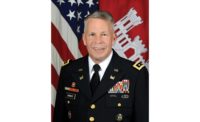Lt. Gen. Thomas P. Bostick, commanding general of the U.S. Army Corps of Engineers, was in New York City on April 18 to attend ENR's annual Award of Excellence dinner. Before he spoke at the event, Bostick talked with Associate Editor Pam Hunter. Excerpts from the interview appear below.
ENR: Like most federal entities, the Corps of Engineers is dealing with a budget crunch. How is the Corps managing its backlog?
Bostick: The Corps has a backlog of $60 billion of authorized projects that we've done some work on. Each year, we have about $1.5 billion to apply against that $60-billion requirement. Looking long term, what we're doing is not sustainable.
We need to determine what our priorities are and what places we want to invest money. Where we have the funds up front, we can get the job done quickly and with the highest quality.
 |
| BOSTICK |
We saw the same thing with the Base Realignment and Closure program. We had a couple of hundred projects—about $12 billion worth of work—and the BRAC 2005 program put into law that the work had to be done by 2011. Many thought it couldn't be done, but the Corps, contractors, national and local communities … worked together, and we got it done.
The fact is, there are examples of difficult missions with very high successes, and the common denominator is funding up front—and a lot of teamwork.
What is the Corps doing to modernize some of its processes?
Internally, we are working on a civil-works transformation … [using] more modern, rapid, less costly planning processes. … We're looking at how we budget. We've been asked to budget by watershed … where all the interests and all the parties work together to sort out what projects within that watershed are best.
Instead of a lot of individual projects around a particular watershed … [federal agencies and local stakeholders] work together [to prioritize and ask] how do we achieve success? Now, we fund [projects] through the stovepipes, and one part of the federal government may be saying this [particular project] is not important, while another does, and our budgets therefore don't link at the local level.
The other thing we're looking at is our infrastructure strategy. Again, what we're doing we cannot sustain. We cannot continue to manage all [our infrastructure] projects. We have some hard choices to make in terms of infrastructure—whether we repurpose some of these, whether we stop doing work or stop maintaining them—and maybe the state or community sorts [out what] they can do.
Another area is project delivery. We've learned from BRAC and post-Katrina that there is a lot we can do to ensure we deliver in a faster manner. [Examples] include early contractor involvement, design-build and innovative financing.



Post a comment to this article
Report Abusive Comment